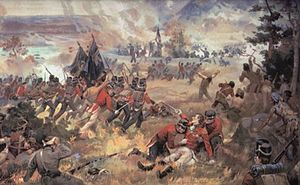Today in History - October 13th
October 13, 1812 - Battle of Queenston Heights during the War of 1812
The Battle for Queenston Heights
On October 13th 1812, War came to the Niagara Frontier. American troops lead by General Stephan Van Rensselaer, crossed the river at Queenston in a surprise attack and captured the Redan battery. It was a large cannon located on the Heights, which was perceived to be a threat to the village of Lewiston New York.
General Brock was in Niagara, in it's present day Niagara-on-the-Lake when he heard of the American Invasion. On his horse Alfred he rode quickly to find part of the American Force pinned down on the rivers edge.
Some of the Americans lead by Captain Wool had gone along the river bank where they found a way up the steep gorge, they climbed to the top and captured the Redan battery by attacking from the rear. The Americans turned the cannon so it was directed at Queenston.
Brock gathered his British troops and Canadian militia and attempted to charge up the Heights against fierce American musket fire. He was forced to order a retreat, but ordered another charge almost immediately. He was leading his men with his sword held high when an American sniper took aim and shot him. The musket ball penetrated his heart and he fell to the ground mortally wounded. He died almost instantly. The counterattack faltered, then retreated down the slope. An aide to Brock, Colonel John Macdonell, arrived with two more companies, renewed the attack, and reached the abandoned gun postion on the heights. Macdonell was killed at about this point.
The Americans on the Heights began to fortify their postition against a British Frontal attack up the escarpment.
British General Roger Hale Sheaffe was leading a British column from Fort George along the river road, and he made a detour back off the river road to remain out of the Americans site. And to bring his troops up the escarpment by a little used path a mile or so west of Queenston arriving at the top of the Heights out flanking the American forces.
By mid-afternoon when British Major General Sheaffe arrived with a relief force there were more than one thousand American troops on the Heights.
Sheaffe found that a small detatchment of British troops and Indians from Chippawa were harassing the Americans with sparatic attacks during which the Indians filled the air with war cries.
The Americans were in a culdasack with the gorge and escarpment on two sides and in their rear and the British in front of them. After more troops and militia arrived from Fort Erie and the forces were about even with about one thosand men each, Sheaffe ordered an attack. After a single volley the British troops moved forward with two hundred Indians who filled the air once more with their piercing war cries. The American Line was shattered. Colonel Winfield Scott tried to organize an orderly retreat to Queenston Landing, but his army was getting cut to pieces. After one half hour or so he called for surrender and the fighting gradually stopped.
The British won the day at Queenston Heights by Sheaffe's prompt counter attack.
The Americans were unable to persuade the thousands of their militia at Lewiston to cross the river.
American Losses:
958 killed, wounded or missing of which 450 were regular army.
Colonel Winfield Scott was taken Prisoner and later paroled on the condition that he not take part again in active Military service.
British Losses:
112 killed, wounded or missing and the British Indian losses were 13 of which 3 all chiefs were killed.

"Push on, brave York Volunteers!" A mortally wounded Brock urges the Canadian militia forward. Apocryphal reconstruction, oil on canvas.

0 Comments:
Post a Comment
<< Home